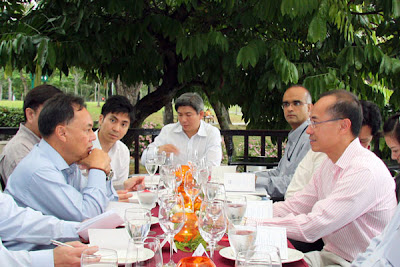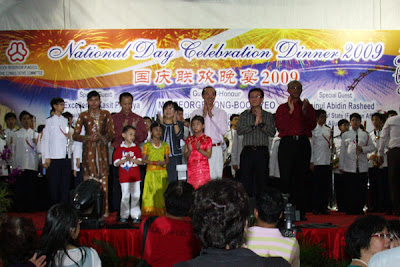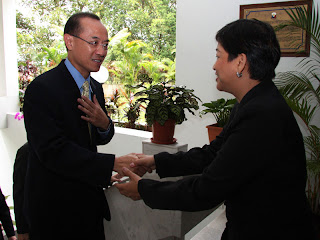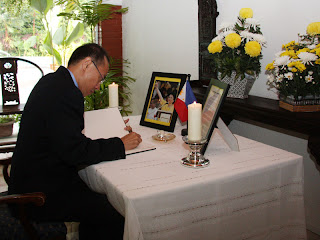[A Piece by Thant Myint-U]The piece below by Myint-U is worth reading. He is a thoughtful son of Myanmar who feels deeply for his country and his people. I learn much meeting him from time to time.
Let's Talk to Burma, China Sure Is
By Thant Myint-U
Sunday, August 16, 2009
Twenty years of sanctioning and lecturing Burma's military regime have failed. The West needs to engage with Burma's leaders, increase humanitarian aid and reopen commercial relations with the country. If it doesn't, not only will positive change remain as elusive as ever, but the country will turn quickly and irreparably into an economic vassal of China.
In a sign of just how impervious the regime is to Western pressure, last week, opposition leader and Nobel laureate Aung San Suu Kyi was sentenced to her fourth spell of house arrest. Two thousand political prisoners remain locked up. And a transition to democracy appears nowhere in sight.
I was born in the United States in 1966 to Burmese parents. My grandfather, U Thant, was then serving as the United Nations' third secretary general. I witnessed repression in Burma firsthand when I was 8, during the violent unrest surrounding my grandfather's funeral.
In 1989, just after college, I spent a year in Thailand and along the Thai-Burmese border, working with dissidents and trying help the first wave of Burmese refugees. Thousands had been killed during a failed anti-government uprising. Suu Kyi had just been placed under house arrest. And the ruling junta, after losing relatively free elections, was refusing to hand over power. Later in Washington I argued with members of Congress and others that maximum sanctions were the best way to topple the
dictatorship. It was an easy argument to make.
By the early 1990s nearly all Western aid to Burma had been terminated, and development assistance through the United Nations, the World Bank and the International Monetary Fund had been blocked. A decade later, embargos and boycotts had cut off nearly all economic ties with the United States and Europe. None of the senior Burmese government officials or their children (these are the only international sanctions targeting children) are allowed to travel to the West.
But as the regime not only survived but began to seek trade, investment and
tourism, I started having doubts. My feeling was that the West should use the opening and find a back door to change while the front door remained firmly shut.
In 2006 I published a book, "The River of Lost Footsteps," in which I argued for a shift in the West's approach. Even when, in 2007, new protests were violently crushed, I still believed greater engagement was the right way. I felt that many policymakers and journalists were missing the bigger picture.
Few seemed aware, for example, that Burma was just emerging from decades of civil war. In the late 1980s and early 1990s, the government and more than a dozen different ethnic insurgent armies hammered out cease-fires, a breakthrough that went virtually unnoticed in the West. (Today, though the cease-fires remain, there is no permanent peace.) And few seemed concerned by the country's grinding poverty, the result of decades of economic bungling as well as embargos, boycotts and aid cutoffs.
In 1991, UNICEF's country director warned of a humanitarian emergency among Burma's children, arguing that more aid couldn't wait for the right government. Eighteen years later, Burma still receives less than a tenth of the per-capita aid handed out to Laos, Cambodia and Vietnam. Tens of thousands die needlessly from treatable diseases.
These challenges have been ignored in the hope that sanctions and tough talk would lead to political change. But that hasn't happened.
Part of the reason is that the people who fashioned the sanctions didn't consider how the rise of Asia's giants -- China and India -- would transform Burma. As American businesses pulled out in the mid-1990s, Chinese and other Asian companies poured in. Hundreds of billions of dollars worth of natural gas have been discovered offshore, and massive hydroelectric and mining projects are being signed. Within two years a 1,000-mile oil and gas pipeline will stretch across Burma, connecting China's inland provinces to the sea. The U.S. trade embargo led to the near-collapse of the garment industry in the late 1990s, throwing tens of thousands of people out of work, but for the regime this has meant little.
Burma today is in no danger of economic disintegration. Without Western engagement, however, Burma's 55 million people risk becoming a virtual colony of their 1.3 billion Chinese neighbors to the east. There is no nefarious Chinese takeover scheme, but the vacuum created by Western policy is being filled.
The old Burmese generals will soon retire, and a new generation will rise to the top. Gen. Than Shwe, Burma's powerful autocrat, is 77 and ailing. Any chance for change requires support from at least some military leaders. Yet we've done nothing to try to influence the worldview of Than Shwe's possible successors. The upcoming generation of officers will be the first never to have visited Europe or America.
Last winter the Obama administration announced a review of Burma policy. I hope it will reconsider the United States' long-standing reliance on sanctions. It's not just that they don't work, but that they've been hugely counterproductive, taking away the one big force -- American soft power -- that could have played a role in reshaping the landscape.
Asia has experienced many successful democratic transitions, and none came about because of the sanctions and lectures that Western powers and advocacy groups seem to think will work in Burma. Generals don't negotiate away their power in the face of threats. You have to change the ground beneath them.
Engagement is not just about talking -- it's about dealing with the powers that be enough to get a foot in the door and create new facts on the ground, especially through economic contacts with the Burmese people. Nor is it based on the notion that economic development will automatically produce democracy, but that we must tackle simultaneously Burma's political and economic ills.
Many in America and worldwide are again outraged by goings-on in Burma. But without new thinking, 20 more years will pass and the dream of a prosperous, democratic Burma will be more distant still.
thant@post.harvard.edu
Thant Myint-U is the author of "The River of Lost Footsteps: A Personal History of Burma."
Do read my posts on
Beyond SG and link up on
Facebook if you have an account















